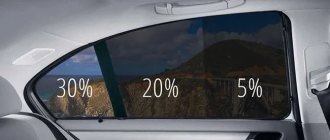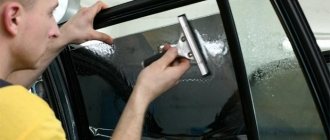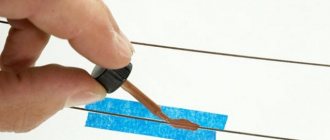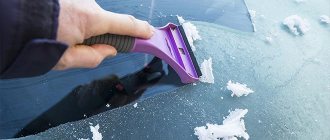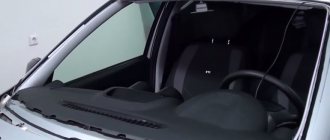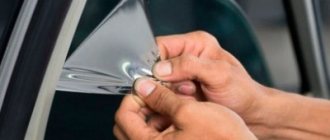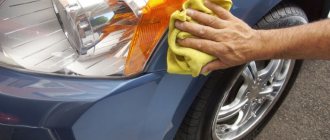Removing tint with a hairdryer
How to remove the film itself? You'll have to remember your school chemistry course. The film consists of a polymer material, and all polymers are destroyed when heated. It turns out that to carefully remove the film you need to heat it with a stream of hot air. Any hair dryer that is usually used to dry hair is suitable for this. In this way, you can peel off the tint almost without streaks.
The main thing is not to exceed the temperature of 40 degrees Celsius, otherwise the film will melt and stick tightly. Or the glass will simply burst. The method is practically professional, relatively affordable and working.
The procedure consists of several stages:
- First, the side window lowers a little.
- All rubber seals are removed.
- Using a hair dryer, the surface of the glass is heated so that the film softens but does not melt.
- Then it is pryed with a knife and moved slightly to the side.
- The film is gradually removed from the entire surface.
Now let's look at popular methods for removing glue from the surface of glass.
How to remove glue from tint
For many drivers, sticky tint stains are a big problem. They wonder how to remove them without damaging the glass or the car itself.
When removing tinting glue, you should not do it yourself, as this can lead to unpleasant consequences. Set a clear plan for what you will do. Follow this plan strictly.
Using soap solution
As a preparation, you can use almost any detergent at hand. The work consists of steps:
- Tinted glass is coated with a solution. Then newspaper is applied to the wet surface, which quickly sticks.
- For 2 hours, the newspaper is constantly wetted with the solution.
- This leads to a softening of the tint. As a result, the film can be easily removed together with the newspaper.
The advantage of this method is that there is no need to search for a soap solution.
Safety precautions
When working with aggressive agents, you need a mask, gloves and goggles.
Most chemicals and folk remedies are toxic and have a pungent odor that lasts for a long time. They can cause burns to the mucous surfaces of the respiratory system. Contact with skin leads to the formation of wounds, so you need to work with them carefully.
Do not smoke while working and generally do not clean near an open fire or near hot objects. Concentrated vapors may cause fire.
Before carrying out work, you should take care to follow safety precautions and prepare safety glasses that will save your eyes from contact with chemicals. A respirator, or in extreme cases a gauze bandage, will protect the respiratory system. Rubber gloves will protect your hands from chemical burns.
Sometimes you have to tint the windows on loggias and in apartments - glue a shading film on them. If you are tired of the darkening or the film needs to be replaced, you can do this in the same way as in a car: first remove the film, then wash off the remaining adhesive base.
Using ammonia
This work is carried out on a sunny day using ammonia. The work order consists of stages:
- A soap solution is diluted to cover the glass. Ammonia is applied on top.
- Small pieces of polyethylene are cut, which after wetting in ammonia are glued to the glass.
- Ammonia and sunlight affect the film. Over time it softens. After this, removing it is not difficult.
This method is harmful to health, so work must be carried out exclusively in a respirator. Ammonia vapors are dangerous.
How to remove from a car?
Car owners decide to remove tinting from car windows for various reasons. Most often, these are requirements for light transmission of glass in accordance with current legislation.
The following circumstances may also serve as a reason to remove the coating:
Coating defects (flaking, blistering, etc.).- Lack of driver comfort when driving due to poor visibility even in slight darkness.
- Glass defects that can only be corrected by removing the film.
- Unaesthetic appearance of tinting, etc.
To begin with, before using chemical reagents, you should try to remove the film in a less aggressive way.
Heated
It can be difficult to pick up and carefully pull off the film by the corner, especially in cases where the coating was glued a long time ago.
To remove the darkening film, you will need the following tools:
- hair dryer (household or industrial, which should be able to adjust the temperature);
- rags or napkin;
- glass cleaner;
- knife.
Work order:
- Turn on the hairdryer.
- Gently heat a small area of the film, starting from the edge. In this case, the adhesive composition will begin to melt. The optimal heating temperature is about +40ºС, the distance to the glass is at least 15 cm.
- Pry the edge with a knife.
- Continuing to warm the surface, moving from one zone to another, gradually remove the entire coating.
- Wash the glass.
The procedure with heating can be carried out only in the warm season. This should not be done in frosty weather, as temperature changes can cause glass to crack.
If the heating is insufficient, a lot of glue may remain on the glass, and the film itself will tear in your hands.
This video will show you how to remove tinting from glass using a hairdryer:
Using tools
You can remove the coating using a cold method yourself , using the following tools for this purpose:
- stationery knife;
- rubber scraper;
- rags;
- glass washing liquid;
- dishwashing detergent or liquid soap;
- nail polish remover with acetone or another product that can be used as a glue solvent.
Procedure:
Using a knife, carefully pry the film off the corner. To do this, you can moisten the edge with water and detergent.- Pulling the loose edge, begin to gradually remove the coating. In this case, you should continue to moisten the part of the glass that is being removed from the coating so that the moisture gets under the film coating.
- Apply dishwashing detergent to the cleared glass.
- Leave for 5-10 minutes.
- Using a rubber scraper, try to remove any remaining glue on the glass.
- If the adhesive layer cannot be completely removed, the surface must be treated with acetone or another solvent.
- Remove any remaining glue with a scraper.
- Wipe the window with a rag.
- Apply glass cleaner to the glass.
- Wait a couple of minutes.
- Wash off the composition from the window with a soft cloth so that there are no streaks left.
The use of detergents and other liquid products requires great care so that the composition does not get under the casing. If there is any doubt whether all the work can be carried out with extreme caution, it is better to press a rag along the border of the lower glass seal.
Chemical methods
In cases where the film cannot be removed using a cold or hot method, chemicals are used. An ammonia solution is used for this.
Usage:
- The selected reagent is applied to the surface of the glass coating.
- A cellophane film is placed on top (you can even use a garbage bag, for example) to prevent the applied liquid from quickly evaporating from the surface.
- Stand for 15 minutes.
- After the film softens - bubbles appear, wrinkles - you can begin to remove it.
- The remaining adhesive is removed with a solvent and a plastic spatula.
- Wash with detergent.
Ammonia can damage surfaces close to the glass, so they must be protected with cellophane film.
Traditional methods of removing glue
In principle, you can also quickly and barbarically tear off the coating, but then sticky traces of glue will remain. How to remove them:
- alcohol glass cleaner;
- soap solution mixed with ammonia (take care of your respiratory system!);
- use a hair dryer and spray bottle to speed up the process;
- Prepare a cleaning solution from dishwashing liquid.
In some situations, even ordinary boiling water fresh from the kettle will help. But this method is only good when it’s warm outside: in winter, such experiments can cause the glass to crack. Just pour a little water on the areas with traces of glue and it will come off.
Porous fabrics (bandage, gauze) remove glue well. Often they don’t need to be impregnated with anything if the tint was removed recently and the glue has not dried. They themselves absorb dirt well. To speed up the process, it is enough to use a biosolvent.
You can use WD40 (rust converter) fluid in combination with a melamine sponge. The result is one hundred percent. You can also prepare a soap solution with formic alcohol instead of ammonia: this will allow you not to wear a respirator and not have to endure the pungent smell of the volatile substance. Just in case, it is better to wear gloves and safety glasses: chemistry is chemistry, even if it seems safe.
Basic DIY film removal methods
You can have the tint removed by a mechanic, but there is a chance to save money by doing it yourself. Removal methods:
- Fast. You need to take the film by the edge, hook it with a sharp part, then pull it off sharply. Typically this method is used in emergency situations.
- Gradual. Tinting is removed slowly, with gradual heating. First, you need to pick up the film by the edge, then take a hair dryer and apply hot air. Heating to +40...+60 degrees is enough for the material to gently move away from the glass. Typically, most of the adhesive composition remains on the film when heated.
The second method is more effective; it allows you to remove the tint with a minimal amount of dirt remaining. Unfortunately, not everyone has a hair dryer, so the process is not always possible. Also, with strong heating, there is a risk of damage to the plastic on the doors; they will have to be covered with wet rags first. You cannot warm up the glass to more than +60 degrees, this will cause a violation of their integrity and deformation.
If it is not possible to warm up the glass, you can remove the tint from it with a soap solution. The film is lifted by the edge and slowly pulled off, pouring the solution over it. Add liquid liberally to the area where the adhesive joins the glass to reduce adhesion. Some of the glue will still remain, but no more than 10-15%. It is imperative to wipe it off: the side windows will begin to roll down poorly, and a lot of everything will stick to them.
Professional products
Currently, many special products are produced for removing glue from glass. For example, aerosol film removers. They are mostly toxic and quite expensive, but they are fast-acting. Here is a sample list of popular chemicals:
- spray “Kerry”;
- “The Anticlean Moment”;
- rust converter “Star Wax”;
- anti-rain Turtle Wax Clear;
- sticker trace cleaner (these are produced under the brands Liqui Moly, Kudo, Spray&Go).
The listed products help to effectively get rid of the marks left by glass tinting glue. Their advantages:
- their active formula is specially designed to remove adhesive stains;
- high quality;
- they are easy to apply;
- some of them have the ability to repel water and work as an anti-rain.
How to remove tint film from glass
Maintenance service workers claim that tinting of any quality can be removed without unpleasant consequences. Walking through thematic forums, we see a different situation; in order to leave no traces at all, you need either experience or good preparation. If the film needs to be removed as quickly as possible, it is pryed from above with a knife and sharply, with force, pulled down. When you don’t need to rush anywhere, it is better to choose more labor-intensive but safe methods.
Attention! Before starting work, you need to inspect the window modules, remove seals and decorative trims that may interfere. Dismantling is carried out carefully, remembering the procedure in order to correctly install the parts in place.
If the movement is too sudden, the material may tear, leaving up to 90% of the adhesive base on the window. If you carry out the procedure slowly, gradually pulling the top edge of the tint diagonally down and towards you (keeping the entire canvas taut), then almost all the glue will go away. When removing material from the side windows, the glass is lowered, then raised little by little. When working, it is advisable to use auxiliary tools that will simplify the process.
To begin with, we will describe a method that gives results, but is rarely used due to the unpleasant odor of the product used - ammonia. Ammonia is generously applied to the surface of the tint film, then the window is completely covered with a piece of polyethylene (garbage bags will do) and left for 60–90 minutes. Under the influence of chemicals, the film gradually softens, deforms, and peels off from the glass.
Soap solution
The mixture is prepared from any soap product (35 ml per liter of water), for example, hand or dishwashing gel, liquid laundry detergent. The thoroughly mixed liquid is poured into a spray bottle. First, spray the top of the film with a small amount of solution and leave for 3–5 minutes so that the liquid penetrates into the gap between the material and the glass. The tinting edge that is slightly behind the surface is moved away with a knife and the film is gradually pulled towards itself and down.
After removing a small piece of film, moisten the tear strip with a soap solution, wait about a minute and repeat the steps until the material is completely removed. To ensure that the tinting does not tear during the process, you need to distribute the pulling force as evenly as possible over the entire canvas. To make it easier, the film is carefully cut directly on the glass with a stationery knife into strips 7–18 cm wide, each “tape” is removed separately. It is better not to do this with tinting on a heated rear window so as not to damage the threads.
Petroleum-containing compounds
Various mixtures of hydrocarbons are known for their solvent effect. They are used to remove traces of stickers, tape, paint and other stubborn dirt. It should be remembered that they are aggressive towards the paintwork of the car. These substances are liquids:
- petrol;
- kerosene;
- white spirit (nefras).
The algorithm for removing glue using these hydrocarbons is as follows:
- Stock up on clean rags;
- Wipe off dirt with a dampened rag;
- Wash the glass with clean water and wipe dry.
You need to work with hydrocarbon liquids with extreme care: they are toxic, volatile, flammable and can damage the paint if they come into contact with body parts.
How to clean the rear window of a car from glue
It is impossible to clean the heated rear window of a car using a scraper or blade. The heating filaments can be damaged, so it is better to use other methods.
When removing film from the rear window, proceed in the following order:
- Remove all seals from the window. This will provide free access to the edges of the tint film.
- Wet the glass with the prepared solution, paying special attention to the top part of the tint. The solution should penetrate under it.
- Separate the coating from the glass and carefully pull it down with both hands. Wipe off any remaining glue immediately.
Car detonation service
Turning to professionals for help is a smarter decision than removing the tint yourself. Control over car tinting is being strengthened, fines are rising, and drivers are worried. In addition, tint sometimes wears out over time and needs to be renewed. But not everyone has the equipment and free time for this.
The price of tinting per unit at River Auto Lab is 500 rubles. You can be sure that the windows of your car will not be damaged at all. The entire process of glass tinting is carried out in full accordance with technology, which guarantees high quality work even when tinting glass with electrical heating.
How to remove tint correctly (for the future)
To leave a minimum of glue from the film, you need to know how to properly peel off the tint from the glass. To carry out dismantling you need to prepare:
- Construction hair dryer;
- Stationery knife.
The procedure is performed as follows:
- Using a utility knife, pry up a corner of the tint film so that you can pick it up with your fingers.
- Heat the hairdryer to 300-400°C.
- Pre-warm the work site.
- Start pulling the film with gentle force. The heated glue liquefies and lags behind the glass.
- Cut off large pieces of the removed film with a utility knife, this will simplify the process.
You can easily wipe off the glue after removing the tint film if you choose the right method. To avoid damaging the glass, you need to use only proven methods and means . You can simplify the procedure and minimize the amount of glue residue by properly dismantling the tint film.
Car tinting is one of the most popular car service services. However, over time, the need arises to remove the tinting material due to its wear and tear, improper operation, adverse environmental effects, tightening of administrative sanctions for tinting, change of vehicle owner and other factors. Cleaning the glass from the film completely is not an easy task, since in most cases sticky adhesive stains remain on the surface, interfering with the normal operation of the car and worsening its appearance.
